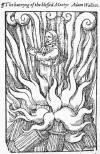|
Adam Wallace, Martyr 12
October 1550
The capture of St Andrew`s
Castle and the sending of John Knox to the French galleys dealt a deadly blow
to the Reformation and gave the priests and prelates confidence that they
could now stifle all opposition to them. By fair means and foul they
sought revenge on all who had been involved in the murder of Cardinal Beaton and any who had subsequently helped the rebels to hold St Andrew`s
Castle. One such victim was the elderly Laird of Raith in Fife. Held in
favour by King James V his fault, if it was such, was to write a letter to
an Englishman about a friend who was held captive. The real reason was
that he was in favour of the Reformation and the prelates would not be
happy until they had his death. He was beheaded, seemingly for treason
(Scotland and England still being in arms), and his estates seized and
given to David Hamilton, the Governor`s youngest son.
The assault on alleged
heretics was led by John Hamilton, Abbot of Paisley and Bishop elect of
Dunkeld, who was the brother of the Governor of Scotland. They
turned their attention to a zealous and upright man, Adam Wallace, alias
Feane from Fail in Kyle, Ayrshire. There was a family of Wallace in Feale,
Fail or Failford in the parish of Tarbolton where there was also a
monastery of the Red Friars established in 1252. Wallace and his
wife, Beatrix Livingston, were friends of Alison Sandilands (daughter
of James Sandilands of Calder) and married to John Cockburn of
Ormiston. Known as Lady Ormiston, her son Alexander was a former pupil of
John Knox, while Wallace had helped educate her children in the absence of
her banished husband. Pursued by the Bishop of St Andrew`s Wallace was
seized at Winton allegedly for preaching, which he denied. He did not
consider himself worthy enough to be a preacher but he did admit private
prayer at table and reading his Bible. He was taken before the Black
Friars in Edinburgh for judgment. There before the assembled might and
authority of the Prelates and nobility of Scotland, Wallace was led in by
Johne Curnocke, a servant of the Archbishop of St Andrews. Made to sit in
the midst of a scaffold he was questioned by the accuser, Johne Lawder,
parson of Marbottle. Wallace rather meekly said he had said no evil to
hurt anybody but was then howled down with the words ” But you are
brought furth for so horrible crimes of heresie as never were imagined in
this countrie before.” These words alone indicate that judgment had already been determined before the prisoner was heard; and then, because he had sensible arguements for his defence, the frenetic papists present endeavoured to ensure the reasons were not heard by anyone. Such was their absurd fear that they would be found wanting.

Wallace`s alleged crimes
were but the usual doctrinal issues of transubstantiation and
the taking of bread and wine in the Communion. Bravely Wallace gave his
views backed up by explanation and Biblical reference. But, as ever in
such cases, if anything was said different to the doctrinal waffle then you were wrong, and thus a heretic – such was the blinkered view of the Papists, in this case led by the Bishop of Orkney would have
none of it and declared him heretic. The second charge was that he called
the Mass “verie idolatrie and abominable in the sight of God” which he
challenged the accusers to find reference to in the Bible when he would
admit his wrong. Again he was damned a heretic. The third charge was
another debate on the use of bread and wine alleging that Wallace had said
that the Papist God ” is but bread and wine, sowen of corne, growing of
earth, baked of men`s hands, and nothing elles.”
The foregone conclusion was
soon reached with but one dissenting voice – that of the Earl of Glencairn
whose family were later of Covenanting principles. Wallace was handed over
to the secular authority, Sir John Campbell, the Justice Deputie, for
delivery to the Provost of Edinburgh for execution. Wallace was taken and
laid in irons around his legs and neck. There was first visited by two
Black Friars who sought his recanting, but they received short shrift and
departed. He was then assailed by John Sinclair,the Dean of Restalrig (
later Bishop of Brechin) who tried to convince Wallace of the propriety of
the Communion and transubstantiation but he too was rebuked and unable to
sway Wallace from his Scriptures. In a further attempt to break the
prisoner`s will and for spite, Sir Hugh Terry, the gaoler on this
occasion, seized Wallace`s small Bible that he carried with him, tucked in
his sleeve. The morning of the execution the prisoner was taken to Castle
Hill where Terry was angered because Wallace wished to speak to the large
and sympathetic crowd, but he refused him. Wallace was, thrust towards the
stake, chained and the fire lit, as the flames rose so the cord around
Wallace`s neck was drawn tight and another martyr`s crown was gained.
|